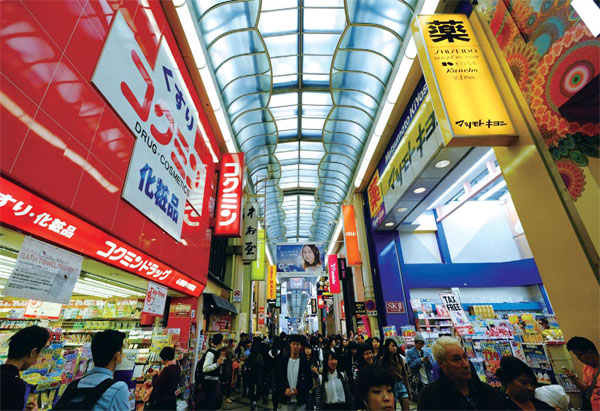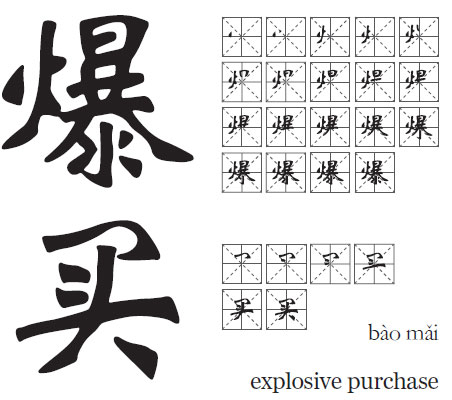Chinese shopping still booming
Updated: 2016-07-08 08:11
By Hatty Liu(China Daily Europe)
|
|||||||||
From milk powder to pricey perfume to toilet seats, the tastes of shoppers overseas have shifted but their ardor hasn't gone away
With the United Kingdom's recent vote to leave the European Union, the Japanese yen rose to its highest level since 2013 as every other Asian currency declined. This prompted media in China to ask: Are we witnessing the end of an era for Chinese "explosive purchases" of goods in Japan?
"Explosive purchase" (爆买, bàomǎi) was actually a neologism coined by the Japanese to describe the buying habits of Chinese tourists visiting primarily for the purpose of buying large amounts of goods to bring back to China.


According to Japan's Tourism Bureau, Chinese visitors spent around 80 billion yuan ($1.2 billion; 10.8 billion euros) in Japan in the past year, an average of 150,000 yuan per visitor. Everything from home electronics to cosmetics to toilet seats was said to be the most beloved items of Chinese shoppers in the country. China's Ministry of Commerce says Chinese shoppers overseas cleaned up 1.2 trillion yuan worth of goods in the past year.
But not all overseas shopping destinations are created equal. Top destinations for Chinese mainland shoppers last year were Hong Kong, the United States, Japan, South Korea, Macao, France, Canada, Thailand, Taiwan and the UK, according to data collected by Mafengwo, a Chinese social travel service, in conjunction with the Chinese Tourism Academy. The most popular items that shoppers buy overseas are baby and maternity products, clothing and accessories (including bags and shoes), and cosmetics.
Hong Kong, a nearby destination, was once a juggernaut source for everything from milk powder to luxury handbags. Searching for news about shopping in Hong Kong these days, however, is more likely to get you news and social media posts about conflict between mainland shoppers and annoyed Hong Kong residents, and how these conflicts are sending shoppers flocking to Japan and South Korea instead. Nevertheless, Hong Kong's location and greater diversity of available of global brands - without high taxes - help it retain its status as a top destination. Hong Kong's Chow Tai Fook jewelers deserve special mention as the most popular brand for Chinese overseas shoppers last year, according to online travel management service Ctrip.
The most popular American brand for Chinese mainland shoppers last year was Tiffany's, according to Ctrip. Other popular American products include athletic wear (one of the fast growing sectors for Chinese overseas shopping), baby products, and health supplements, including melatonin, vitamins, and fish oil.
Chocolates are also a popular purchase in both the US and Canada. A gift guide published by Vancouver's lahoo.com recommended, alongside predictable items such as Adidas shoes, items like ginseng, cosmetics, Costco-brand lint rollers and Kitchenaid items for Chinese visitors to take home.
According to a survey of overseas shoppers by people.cn, the South Korean products most beloved by Chinese mainland shoppers this year were cosmetics, including both make-up and items such as shampoo and skin-care products.
Consumer satisfaction rates for South Korean-branded cosmetics continued to increase in the past year even as overall consumer satisfaction for South Korean products - food, electronics and even entertainment - decreased. Survey respondents said they preferred shopping in South Korea for the "good quality and low price" (物美价廉,wù měi jià lián).
Japan, by contrast, is not known for being cheap, but seems to have a greater variety of products to attract Chinese mainland shoppers to its shores.
The most popular Japanese brand according to Ctrip was Zojirushi, of rice-cooker fame. One duty-free shop in Akihabara, Tokyo, made the news last year by reporting that more than 80 percent of the rice cookers they sold were bought by Chinese shoppers.
However, in terms of the sheer numbers sold, Japanese media report that over-the-counter medicines and cosmetics are at the top while rice cookers are in fifth place. Japanese medicines are reported to be popular because of their quality and safety, as well as combining modern medical knowledge and ingredients familiar to users of the traditional Chinese medicine. Cosmetics, as in the case of South Korea, are popular due to the perception that they are more suited to Chinese skin and hair types than Western products.
The European and American cosmetic industries are not exactly hurting for Chinese business. Perfume is the preferred product of many Chinese who visit France, with Chanel being the top brand according to Ctrip. In the UK, Ctrip reports Burberry as a major preferred brand, but Mafengwo also provides a list of popular "middle-income high street" fashion retailers such as River Island and Topshop.
As for Thailand, Sina reports that tourists typically bring back food items such as seaweed snacks, instant noodles, dried durian fruit, and Royal-brand milk tablets, in addition to sunscreen, bug repellant and Tiger Balm for pain relief.
In the case of two countries that are not yet considered tourist hotspots, data from Taobao show that 99.9 percent of orders coming into China from Iceland last year were of cod-liver oil, while 49.7 yuan of every 100 yuan spent on orders from South Africa were of Zam-Buk multipurpose ointment. Could these be signs of the future?
A final note: Contrary to last year's viral social media photos of Chinese shoppers panic buying (抢购) Japanese toilet seats, toilet seats accounted only for 0.8 percent of total Chinese purchases in Japan, according to a Chengdu research company. They are popular because of such features as deodorizing, self-cleaning, drying and self-disinfecting.
Courtesy of The World of Chinese, www.theworldofchinese.com
The World of Chinese
(China Daily European Weekly 07/08/2016 page23)
Today's Top News
Britain set for its second female prime minister
UK Iraq report highly critical of Tony Blair
UK invasion of Iraq was not last resort: Report
Berlusconi accepts Chinese offer for AC Milan
UK consultancy loses license, Chinese graduates being told to leave
Chinese online retailers offer 'Brexit sales' as sterling hits record lows
British PM race cut to 3 hopefuls
Suicide bombers hit three Saudi cities
Hot Topics
Lunar probe , China growth forecasts, Emission rules get tougher, China seen through 'colored lens', International board,
Editor's Picks

|

|

|

|

|

|







